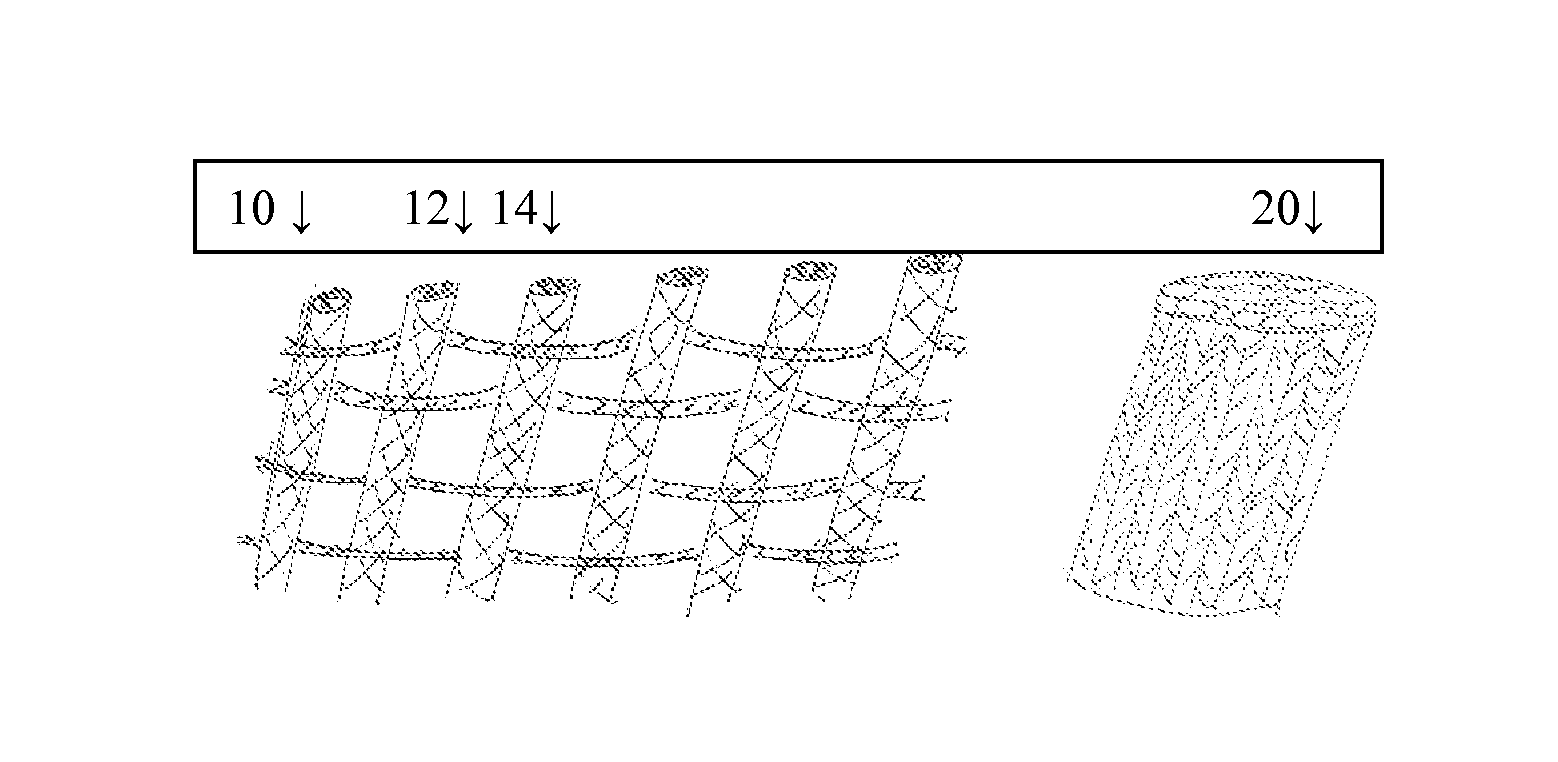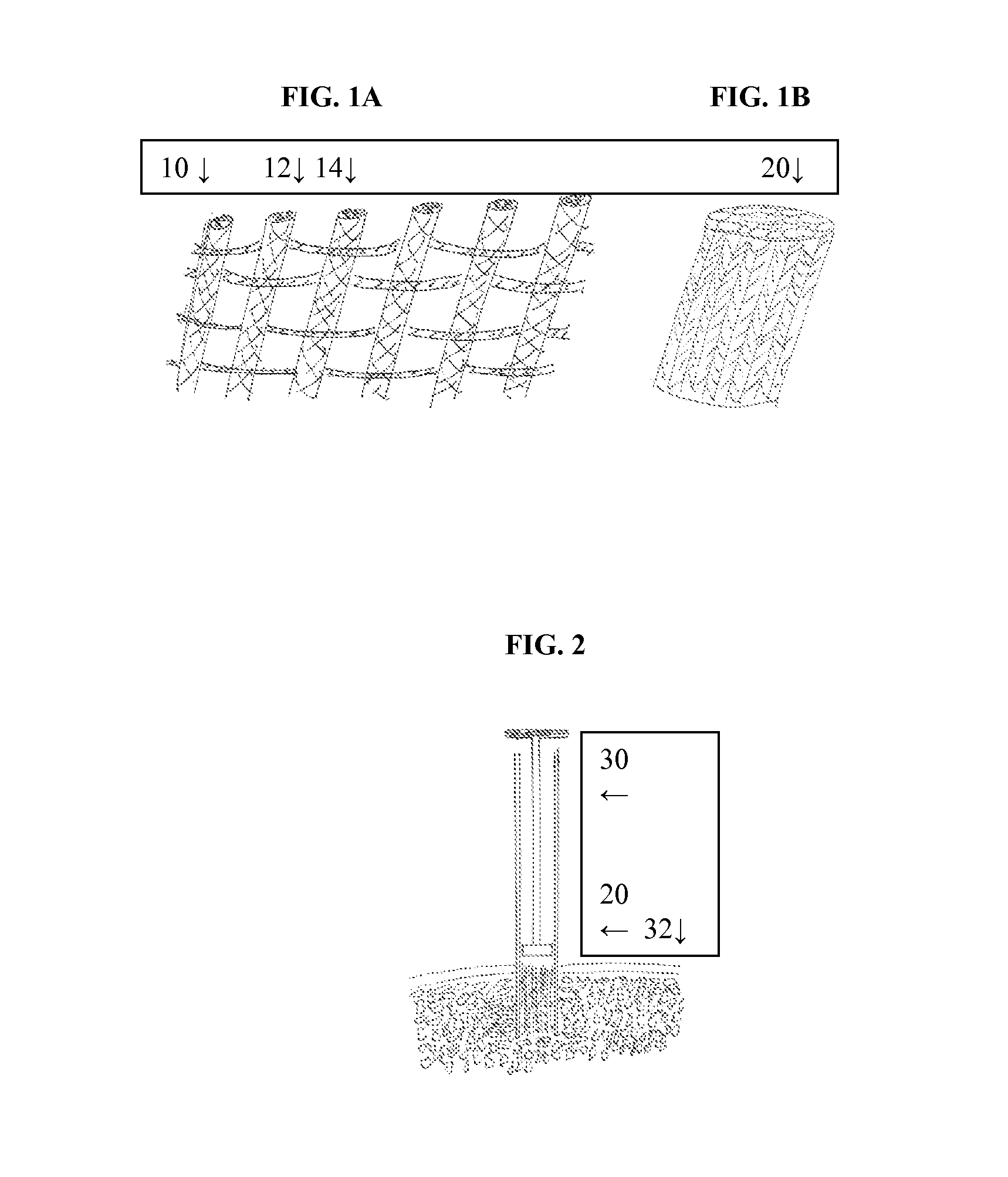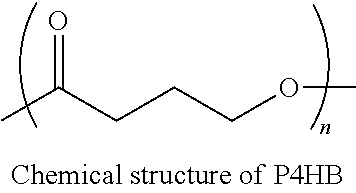Implants for Soft and Hard Tissue Regeneration
a soft and hard tissue regeneration and implant technology, applied in the field of implants, can solve the problems of difficult to distinguish a single initiating change in either tissue, further degeneration, etc., and achieve the effect of enhancing osteointegration
- Summary
- Abstract
- Description
- Claims
- Application Information
AI Technical Summary
Benefits of technology
Problems solved by technology
Method used
Image
Examples
example 1
Manufacture of Knitted Braid Mat
[0073]P4HB (Mw 350 kDa) was melt spun and drawn to produce a monofilament fiber 0.13-0.18 mm in diameter with a tensile strength of 1.8 kg and break elongation of 30%. Sixteen spools of the monofilament were then braided to form a 20 ppi braid that was approximately 1 mm in diameter. The braid was then knitted using a weft insertion knitting machine with a 2 dpf, 120 denier multifilament P4HB warp fiber with an average strength of 6 gm / denier and break elongation of 30% to make a 25 mm wide mat with the braids evenly spaced. There were 6 warp knits, and 20 weft insertions per inch.
[0074]The mat was then cut into pieces 1 cm wide and 35 mm long. These were then rolled to form a cylindrical implant approximately 7 mm in diameter and 1 cm tall.
example 2
Ceramic Coating of the Implant
[0075]A solution preparation formula (for a total aqueous volume of 1 L) is given in Table 1 for preparing implants with ceramic coatings. The first five chemicals given in Table 1 were added, in the order written, to 950 ml of de-ionized water in a glass beaker of 2 L capacity. Before the addition of the next chemical, the previous one was completely dissolved. After all the reagents were dissolved at room temperature, the solution was made up to 1 L by adding additional water and then filtered with a Nalgene MF75 (90 mm) filter unit for sterilization. This stable sterile stock solution of pH value of 4.35-4.40 could be stored at room temperature in a capped bottle for several months without precipitation.
TABLE 1Stock solution preparation recipe, for a total volume of 1 LConcen-AmounttrationSupplier,ReagentOrder(g)(mM)Cat # & Lot#NaCl158.44301000EMD; 7710; 0613B62KCl20.37285Mallinckrodt; 6838;6838Y21610CaCl2•2H2O33.675425EMD; CX0134-1;K92681900MgCl2•6H...
example 3
Implantation Study
[0081]Materials and Methods
[0082]A total of six (6) adult goats were enrolled into a study. Two full thickness osteochondral defects, 7.0 mm in diameter by 10.0 mm deep, were created in the middle lateral trochlear sulcus and in the medial femoral condyle of one stifle of each goat. The medial femoral condyle site was exposed to full weight bearing following cast removal while the middle trochlear sulcus will be a protected, limited loaded site. The devices implanted were either ceramic coated or non-coated, and were prepared according to Examples 1 and 2 above. Three goats had ceramic coated implants and three goats had non-coated implants. At the time of implantation blood immediately wicked up into the implants demonstrating the effectiveness of the design. Postoperatively for all animals, the operated rear limb was placed into a modified-Thomas splint for 14 days.
[0083]On day 84 (12 weeks) after surgery, animals were humanely euthanized. The left and right femo...
PUM
| Property | Measurement | Unit |
|---|---|---|
| Diameter | aaaaa | aaaaa |
| Diameter | aaaaa | aaaaa |
| Porosity | aaaaa | aaaaa |
Abstract
Description
Claims
Application Information
 Login to View More
Login to View More - R&D
- Intellectual Property
- Life Sciences
- Materials
- Tech Scout
- Unparalleled Data Quality
- Higher Quality Content
- 60% Fewer Hallucinations
Browse by: Latest US Patents, China's latest patents, Technical Efficacy Thesaurus, Application Domain, Technology Topic, Popular Technical Reports.
© 2025 PatSnap. All rights reserved.Legal|Privacy policy|Modern Slavery Act Transparency Statement|Sitemap|About US| Contact US: help@patsnap.com



